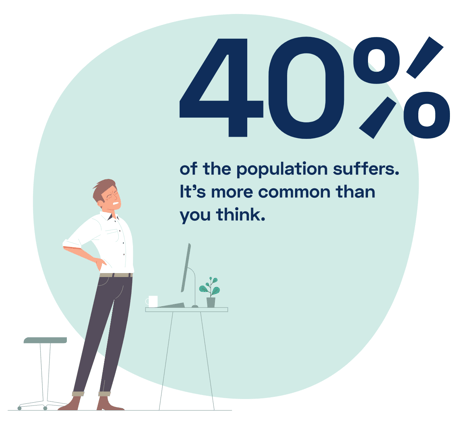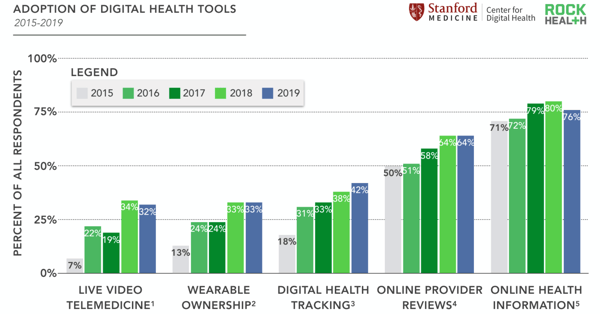Your Complete Guide to Digital Health Solutions in 2020

Table of Contents:
I. Digital Health vs. Digital Therapeutics
II. Is Digital Health Worth it?
III. Are Digital Health Solutions Right for Our Organization?
IV. What are My Options for Adding a Digital Health Solution?
The power of smartphones combined with breakthrough medical technology and artificial intelligence are quickly changing how consumers think about healthcare. This paradigm shift in healthcare access and delivery is making its way into the workplace ... into YOUR workplace.
Digital health solutions delivered by mobile apps are powering a consumer-driven healthcare economy, one that is completely reshaping the wellness and healthcare benefits landscape. For example, whether one is managing a chronic health condition, caring for a sick child, or training for a marathon, digital health tools or solutions are making it easier to track, diagnose, and manage our lives – and improve overall health and wellbeing.
I. Digital Health vs. Digital Therapeutics
Digital health represents the convergence of medicine, health, information, and technology. But there’s an important distinction between the two.
According to the Digital Therapeutics Alliance, the term “digital health” means any technology that engages patients for health-related reasons. This broad category covers a wide range of general wellness and health products, including apps such as Fitocracy, Fitbit/Fitbit Coach, Lifesum, and Home Workout. The Google Play store (Android) and Apple App Store (iOS) have thousands of free and low-cost health, wellness, fitness, and nutrition apps.
Digital therapeutics – on the other hand – is a separate category of evidence-based products within the broader digital health landscape. The primary function of digital therapeutics is to deliver software-generated therapeutic interventions directly to patients to prevent, manage, or treat a medical disorder or disease. Digital therapeutics offer the employer the ability to improve patient outcomes and lower treatment costs. They accomplish this by replacing the need for a drug or working alongside “gold standard” therapy to help with chronic conditions such as musculoskeletal (MSK) lower back pain or diabetes.
“Digital therapeutics are about to become a true medical alternative that will utilize communication-based technologies, apps, and software to improve patient outcomes and help to lower the cost of healthcare.”—Kamaljit Behera, transformational health industry analyst at Frost & Sullivan
Overall, digital therapeutics come with a higher level of evidence and are destined to make further inroads into the traditional covered and reimbursed healthcare models involving employer, payer, and provider. The most serious of these apps are those that have achieved or are seeking FDA clearance based on randomized, controlled clinical trials.
But why should employers embrace this new digital approach to health and wellness? And how do large organizations plan for effective integration of digital health into an overall wellness strategy that targets the biggest drivers of health costs?
1. Your Employees are Already There

Your employees are probably ahead of the game, already using digital health, and they increasingly expect their employers to be there as well. The annual Rock Health national survey on digital health adoption trends clearly demonstrates the transition to a progressively more digital consumer healthcare experience. While overall consumer adoption of digital health has backed off slightly from its 2018 high, more than 75% of all consumers use online health information. Forty-four percent of respondents track some aspect of their health digitally and one in three owns a wearable. Employees across the spectrum increasingly expect to access and review health information digitally, proactively, and interactively – especially for recurrent health conditions.
Image Source: 2019 Rock Health Digital Health Consumer Adoption Survey
2. Health Insurers are Onboard with Digital
Major US insurance providers are now recognizing the benefits of digital health solutions. Cigna has partnered with Omada Health to deliver a digital diabetes coaching and prevention program to national and regional employer customers. CVS Health–owned insurer Aetna recently launched its Attain app for Apple Watch. Attain combines wearable and claims data so users can set activity goals and milestones while earning rewards for healthy behavior. Other major insurers are rolling out similar mobile apps. New digital therapeutic platforms such as Welldoc are offering multiple apps to employers, giving employees access to real-time coaching and education, as well as the ability to share blood glucose data with a healthcare provider.
3. Health Providers are Playing Nicely with Digital
You may be wondering, “Do the providers that our employees see use digital health, and do they even know what it is?”
A recent survey conducted by PatientPoint and the Digital Health Coalition found that three quarters of physician participants credited improved patient engagement with digital patient engagement tools, and 95% of participants had some form of digital education tool in their offices based on this belief.
Patient engagement equals better outcomes and happier employees. By embracing digital health, employers can gain competitive advantage, save money, and increase engagement and job satisfaction by meeting the increasing demand for self-directed healthcare.
“Patient engagement in decision-making [is] associated with increased patient satisfaction and improved health outcomes.”—Mary Meeker, director and founder at Bond Capital Associates LLC
4. Your Competitors are Embracing Digital
Companies that hesitate on adding digital health employee benefits may find themselves left behind in the highly competitive US job market. Mercer’s 2017 National Survey for Employer-Sponsored Health Plans finds that employers large and small are already offering their employees numerous health-focused voluntary benefits. These benefits close gaps in their core health plans and boost employee productivity and satisfaction. According to the Castlight State of Digital Health 2018 Annual Report, the average employer today now has 14 distinct digital health solutions, 5 of which they contract with independently outside their health plan.
In a recent Harvard Business Review Analytic Services survey of 238 employers, 77% reported believing that offering “innovative” health benefits to employees is a key factor in competing for workers in a tight job market. Of those surveyed, 57% said the number of health benefits offered is rising. Further, just over half said they believe health benefits will be an even bigger strategic priority in a competitive job market in the future than it is today.
5. Digital Health is Mainstreaming
Digital health is introducing employees and employers to a new way of managing and improving wellbeing, especially for chronic and costly challenges related to mental health, diabetes, and MSK pain. For self-insured employers, this means the payer assumes the upfront cost of the digital health solution. The increased awareness of and demand for digital health is driving growth around the world, with Transparency Market Research forecasting the global digital health market to reach $536.6 billion by the end of 2025.
Major industry groups have been established to promote the advancement of – and establish standards for – digital health and digital therapeutics, including the Digital Health Coalition, Digital Therapeutics Alliance (DTA), and Digital Medicine Society (DiMe). In the US, the FDA is helping advance digital health by providing guidance and clarification on which digital health products fall under regulatory oversight. The FDA recently updated its industry guidance to help determine which technologies require regulatory approval and which are considered low-risk “general wellness” products outside the scope of FDA regulation.
II. Is Digital Health Worth it?
You might be wondering, “Is digital health really worth it, and how can I use digital health to target major cost drivers such as diabetes and MSK disorders for my company?" Return on investment (ROI) is the traditional go-to measure of whether a new program, service, equipment, or vendor is worth it. However, in the healthcare and benefits world, demonstrating a tangible ROI on corporate wellness programs is challenging. This is because we’re often dealing with intangibles that go beyond a strict ROI calculation. These include things such as current health status, degree of wellness, absenteeism due to health issues, overall job satisfaction, and employee engagement.
More businesses are turning to a different method of measuring corporate health and wellness program success: value on investment (VOI). These organizations view employee benefit offerings as a value center, not a cost center. Taking a broader, more holistic view of employee health, there are 4 key measures of value to consider when introducing a digital health solution:
- Direct medical cost savings: Does the corporate spend per employee decrease after introducing the digital tool compared with the standard of care?
- Prevention:
- Does the digital health solution prevent employees from developing a condition that requires medical spend in the future?
- Disability claims: Is there a decrease of long- and short-term disability claims?
- Productivity: Is there an increase in productivity by reducing lost workdays or presenteeism?
- Competitive advantage: Is the company better able to attract and retain talent through a competitive benefits package?
 In a 2018 Castlight Health interview, Mercer Principal and Senior Consultant Sander Domaszewicz described how companies are approaching the valuation of employee wellness programs in digital health. Domaszewicz said that benefits have evolved into a way for employers to differentiate and add value, approaching digital health as an investment as opposed to a cost.
In a 2018 Castlight Health interview, Mercer Principal and Senior Consultant Sander Domaszewicz described how companies are approaching the valuation of employee wellness programs in digital health. Domaszewicz said that benefits have evolved into a way for employers to differentiate and add value, approaching digital health as an investment as opposed to a cost.
III. Are Digital Health Solutions Right for Our Organization?
Here are some important questions to answer when considering implementing a digital health solution or digital therapeutic into your employee wellness or healthcare offerings:
- Can the payer seamlessly integrate the digital health tool with your existing wellness programs and healthcare delivery system, creating a customized engagement?
- Is your organization able to identify and target those employees who will benefit the most from effective digital health solutions, particularly in the management of chronic conditions?
- What is the employee experience, engagement level, and impact of a particular digital health solution or platform at other organizations?
- Are your organization’s expectations of digital health aligned with your employees’ expectations and needs?
- Can the digital health offering scale with your organization?
- Does the digital health solution leverage the power of artificial intelligence to learn, personalize, customize, and accompany each patient on the journey to better health?
- Does the digital health tool have a strong level of scientific and clinical validation behind it?
- Is the digital health tool or solution FDA-cleared or on the path to FDA clearance, building evidence with randomized, controlled clinical trials? FDA clearance may not be a prerequisite for an effective solution. However, an increasing number of digital health apps are going the FDA clearance route for better reimbursement and competitive advantage.
IV. What are My Options for Adding a Digital Health Solution?
Several options exist for organizations looking to add a digital therapeutic to their benefits lineup. Digital therapeutics can be:
- Offered as a stand-alone, employer-sponsored voluntary benefit.
- Bundled with group medical coverage.
- Implemented as an off-cycle benefit for a more strategic, rewarding approach to employee benefits.
According to the Healthcare Information and Management Systems Society (HIMSS), patients who are engaged and act as decision-makers in their own medical care tend to be healthier and have better outcomes. A clinically validated, easily accessible digital therapeutic can benefit your organization by reinforcing the “magic triangle” relationship among employee, employer, and payer.
- Employees want flexible, affordable healthcare benefits, delivered digitally and immediately, whenever possible.
- Employers want decreased costs and happier, healthier employees.
- Payers want more efficient care delivery with better outcomes, as well as engaged, satisfied enrolled members.
Digital health marks the convergence of being able to meet these desires effectively and efficiently, while catering to the needs and wants of a diverse population spanning multiple generations of workers and healthcare challenges. Are you ready to adopt digital health in your workplace?
Interested in taking the next step toward a healthier and more engaged population? Schedule an intro call or demo with the Kaia Health team.





